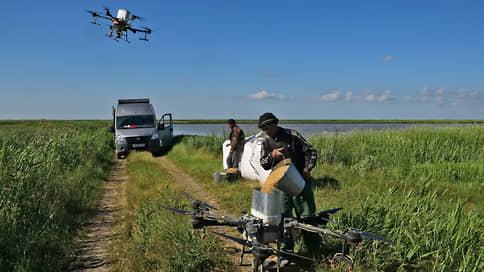Ministry of Economy proposes to exclude agricultural drones from flight bans
[ad_1]

As it became known to Kommersant, the Ministry of Economy has found a way to allow the use of agricultural drones in the face of a flight ban imposed in most of the country. By September, an experimental legal regime (EPR) can be launched in 12 regions, in which 25 operators will be able to work. Now the ministry is considering applications for the launch of EPR for the delivery of goods and monitoring in 19 more regions. Some interlocutors of Kommersant believe that the EPR may be the only way to use drones in the event of an extension of the bans, so such regimes should be expanded rapidly. Others do not consider this approach a panacea.
As it became known to Kommersant, the Ministry of Economy proposes to exclude only drones for agriculture from the flight ban regimes introduced in most regions. As Vladimir Voloshin, director of the digital economy development department of the ministry, clarified to Kommersant, for this it is proposed to introduce an experimental legal regime (EPR) of the BAS Consortium (created by Russian Post and Skolkovo Capital).
EPR will operate in 12 regions – Saratov, Volgograd, Nizhny Novgorod, Novosibirsk, Ulyanovsk, Tambov, Astrakhan, Voronezh, Lipetsk regions, Stavropol, Altai Territories and Tatarstan. Other regions may also join the project, but not those located in the border zone, Mr. Voloshin added. Initially, the Belgorod Region was supposed to participate in the EPR.
Drone flight bans have been in place since October 2022 and are in effect in 60 regions. From March 1, 2024, a government decree will come into force that allows the launch of drones up to 30 kg over populated areas, and also simplifies the procedure for coordinating work for agricultural drone operators.
If the regions do not lift the bans, flights will be allowed only within the framework of the EPR. Today, three “unmanned” EPRs are already operating in the Russian Federation in six regions: these are Bashkiria, Tomsk Region, Kamchatka Territory, Chukotka Autonomous Okrug, Yamalo-Nenets Autonomous Okrug and Khanty-Mansi Autonomous Okrug.
EPR participants will be able to perform work by simply submitting a flight plan in a declarative manner. In February, the BAS Consortium reported that Agrimax. Aero”, “BVS-agro” and “Industrial drones”. To date, applications have already been submitted by about 25 operators, “including those with domestic heavy UAS,” a Kommersant source close to the consortium specified, without specifying the companies.
Now almost exclusively Chinese equipment is used in agriculture – up to 1 thousand drones weighing more than 30 kg (see Kommersant of July 31). At the same time, as explained in the Russian Grain Union, this season, due to bans, drones were massively used only in monitoring to survey fields. Permits for the operation of agricultural drones (as well as for the transportation of goods and extinguishing fires) under the EPR were valid only in Bashkiria. At the same time, in some regions, “flights in situations of emergency” were coordinated as flights of experimental aviation (EA), clarified the sources of Kommersant.
According to the Air Code, EA includes aircraft used for development, research and testing of equipment. The Ministry of Industry and Trade stressed to Kommersant that such aviation cannot carry out aviation and chemical work for commercial purposes, but can carry cargo and official passengers, be used for fire fighting, duty of aviation forces and search and rescue equipment. The Ministry of Transport, the Federal Air Transport Agency and the NTI did not answer Kommersant.
The solution to the problem of prohibitions “shadow leaving in EA” cannot be, the interlocutors of Kommersant confirm. An attempt to coordinate flights in this way is not only illegal, but “difficult and unpromising for business,” says Maxim Chizhov, CEO of Agrimax.Aero. The company hopes for relief, which should come into force on March 1, 2024, “so that when flying for agricultural operations, you do not have to coordinate work with the zonal ATM center.” Then, Maxim Chizhov believes, “it will be possible to immediately destroy the locust, and not wait for days until it devours not only the field requiring cultivation, but also the neighboring ones, as it is now in the Astrakhan region.”
But, if the regions extend the bans, these relaxations will not work, and some market participants believe that the only way out can be “the widespread establishment of EPR wherever possible.” As the Ministry of Economy clarified to Kommersant, now eight more applications for EPR are being processed in 19 regions, including in Moscow (only Zelenograd) and St. Petersburg. Within the framework of the EPR, it is planned to transport goods, cultivate fields, monitor forests and extinguish forest fires, as well as “technological tests”.
Some of Kommersant’s interlocutors doubt that EPR will be installed in most regions. Kommersant’s source in the expert community sees two risks of EPR: non-admission of “objectionable” operators to work and non-uniform control, which can “cast a shadow on the entire industry at the first emergency.” EPR is “not a solution to the problem of regulating the industry, but its crutches,” adds Sergey Detenyshev, Chairman of the Board of MalAP. The key goal of the EPR, he recalls, was the development of new legal models and uniform standards for the operation of drones in the common airspace, the removal of administrative barriers. So far, in his opinion, the ongoing experiments do not contribute to the creation of uniform standards.
[ad_2]
Source link





